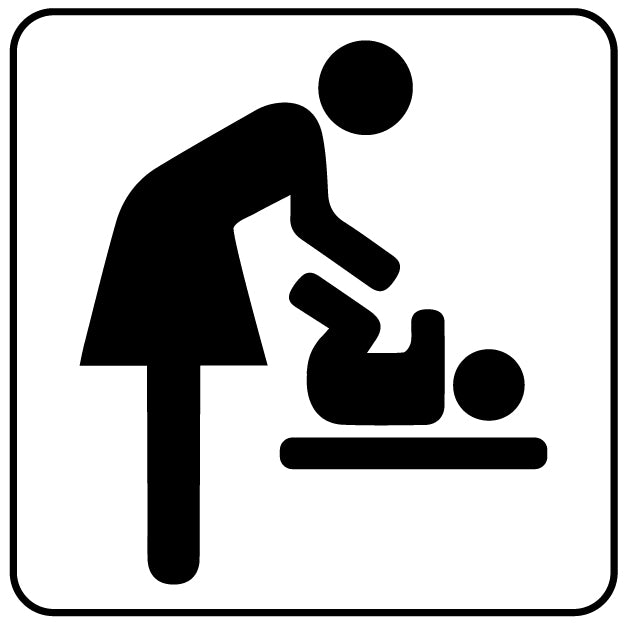
ADA Requirements for Baby Changing Stations
The ADA went into effect in 1990. It is designed to guard against discrimination against persons with disabilities. In the early stages of its drafting, babies and their caregivers, particularly caregivers with disabilities, were included in the act's considerations. Regulations affecting baby change stations were also added since they can affect persons with disabilities who use bathroom stalls that contain them. Understanding this will help make sense of the regulations.

Height Requirements for Various Baby Changing Station Types
Different types of baby changing stations have different proportions. Here are the height requirements for various models. Most manufacturers agree that the upper edge of most baby stations should be between 28.7 and 31.4 inches.
Knee Clearance
Stations mounted next to a toilet must allow room for the legs of handicapped users. A total of 27 inches in height and 11 inches in depth are needed for the indentation meant to allow space for the knees and legs of users. There must be at least 9 inches of space between the lowest edge of the station and the floor.
Protrusion Limits
Changing stations may extend outward from the wall of the stall while in the closed position no more than 4 inches at maximum.
Changing Station Operation
Baby changing stations must be able to be used with just one hand. They must not require tight grasping or vigorous effort to operate. The force needed to use the station cannot exceed five pounds. The forward reach of a wheelchair-bound user must not exceed 48 inches, and there must be at least 15 inches of clearance between the floor and the bottom of the station.
The Working Surface
The working surface is the platform created when the baby changing station is in the open position. The ADA states that this surface should be no higher than 34 inches and no lower than 15 inches above the finished floor when in the open position.
Side Reach Use
Some users may operate a baby chancing station from the side. For this type of use, a seated user must need to reach no more than ten inches from the side of their chair to the back edge of the door of the changing station when it is in the closed position. This will be affected by the size of the stall, the position of the toilet, and the presence of any other obstacles or potential obstacles.
Why Adhere to ADA Regulations?
As mentioned in the introduction, offering baby stations helps ensure your business is competitive with others that employ them. By adhering to ADA regulations, business types that are required to have baby changing stations in their public bathrooms can avoid fines and fees for noncompliance.
But the ADA regulations are not just about urging compliance. They are about providing a safe and high-quality experience for persons with disabilities. This further helps ensure that your business is competitive in your area of operation and in your industry as a whole.
FAQs
Can baby changing stations be in a handicap stall?
Yes. This is the purpose of the Americans with Disabilities Act having regulations that cover baby changing stations. Not all restrooms must have baby changing stations, but those which do are required to adhere to the perimeters and proportions described above. In fact, most baby changing stations are mounted in handicap stalls because these stalls tend to be larger and easier to install while adhering to the existing regulations and recommendations.
Are Baby Changing Stations Required In Public Restrooms?
No, the ADA does not require baby changing stations in restrooms. But some locations have regulations that require handicap bathroom stalls, and these are generally the best places to install baby changing stations. Because these stations tend to be installed in handicap stalls, the ADA has sought to create guidelines that will protect handicapped persons from being cramped by the presence or design of the changing station. The manufacturers of baby changing stations have their own recommendations, some of which conflict with ADA guidelines.
Laws and regulations around baby changing stations are complex, and vary between jurisdictions. Learn more about baby changing station laws in our guide.
Are Restaurants Required to Have Baby Changing Stations?
Recently, several states have passed laws that necessitate that both men's and women's bathrooms in restaurants should have baby changing stations. The ADA recommends that all restaurants have them, but they may or may not be required in the state and city you run your business in. Of course, for practical purposes, it is best practice to install changing stations in all bathrooms that are open to the public, especially for hospitality businesses, hospitals, and the like.
How Much Weight Can A Baby Changing Station Hold?
Some manufacturers claim that their baby changing stations can support as much as 400 pounds. The average claim is that most will hold as much as 250 pounds. However, it is recommended that users should never burden a baby changing station with more than 50 pounds of weight.
